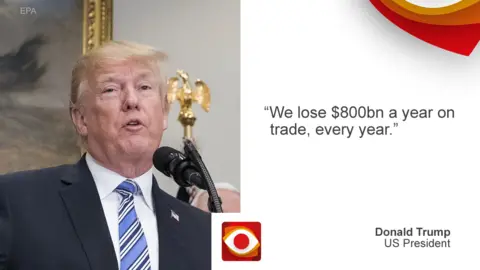US trade: Is Trump right about the deficit?
 BBC
BBCClaim: The US is suffering from a trade imbalance, with a trade deficit of $800bn (£579bn) in 2017.
Reality Check verdict: The President is incorrect about the US trade deficit - it was $566bn (£410bn) in 2017. Economists generally agree that neither trade deficits nor surpluses are necessarily 'good' or 'bad' for an economy.
In a marked change of direction from his predecessors and decades of American trade policy, US President Donald Trump signalled a shift away from free trade towards more protectionist policies by signing two proclamations which levied significant tariffs on imports of steel and aluminium into the United States.
Part of his justification for the move was his belief that US trade deficits have hurt the US economy.
In remarks at the White House announcing the trade tariff plan, President Trump said "we lose $800bn (£578bn) a year on trade, every year".
It's a claim he's made repeatedly, in tweets and speeches.
What's he referring to?
President Trump seems to be citing the fact that the US imported $810bn worth of goods in 2017. That was what he referenced in a June 2016 campaign speech in Pittsburgh, which many in his administration are pointing to now to suggest they've fulfilled a campaign promise.
But in doing so, he's ignoring the amount of services the US exported in 2017, which totalled $242.7bn.
Discounting that contribution to US trade ignores a significant part of what makes the US economy tick.
This is why most economists agree that the US trade deficit in 2017 was $566bn (£410bn).
Like many developed economies, the US has shifted over the past century from an economy primarily focused on manufacturing goods to one that is primarily composed of services. The service sector accounts for 90 million US jobs and 80% of US economic activity, according to the Bureau of Economic Analysis.
The biggest US service exports were travel and tourism, financial services like banking, and environmental services.
 AFP
AFP
What about China?
In the White House speech, and in recent days, President Trump has taken particular aim at China - saying the US is losing out because of a $500bn trade deficit with China, which he also mentioned during a 5 March speech.
However, the US has never run a trade deficit with China that is above $337bn.
Over the past ten years, the US has run an annual trade deficit with China that's hovered between $200bn and $300bn.
And when it comes to steel and aluminium imports to the US, China barely ranks.
Although China has nearly half of the world's steel-making capacity according to the OECD, the US imports the majority of its steel from Canada, Brazil, South Korea and Mexico.
In 2017, Chinese steel imports accounted for just 2% of the 34 million tonnes of steel the US imported, or 3% of the total value.

Manufacturing jobs lost
Allow X content?
A big reason President Trump has pursued these tariffs is his desire to appeal to manufacturing workers in Democratic swing states like Ohio. He has specifically said he wants to see the US return to being a country that "makes" goods.
In the past, he's cited statistics that he says indicate that poor trade policies have hurt the US manufacturing sector overall.
For instance, in a tweet earlier in the week President Trump said that since President George H.W. Bush came into office in 1989, the US has lost 55,000 factories and six million manufacturing jobs.
According to the US Census bureau, the US actually lost a total of 77,314 manufacturing establishments from 1989 until 2014 (the last year for which data is available).
However, establishments can encompass anything from a traditional factory to something like a bakery or a candy store, so it is hard to definitively say if more than 70,000 factories were lost in the intervening decades.
In terms of manufacturing employment, these numbers are slightly exaggerated. The US lost a total of 5.5 million manufacturing jobs since 1989.
US manufacturing employment peaked in 1979. It suffered its sharpest declines in employment in the early 1980s. Since then, manufacturing employment in America has been on the decline.
Some of the decline is certainly due to unfair trade practices - but a large portion of it could be due to automation, which has resulted in fewer workers on factory floors.
It bears mentioning that manufacturing employment has declined in most major western industrialised nations over the past few decades as well, although the timing of the decline has varied from country to country.




